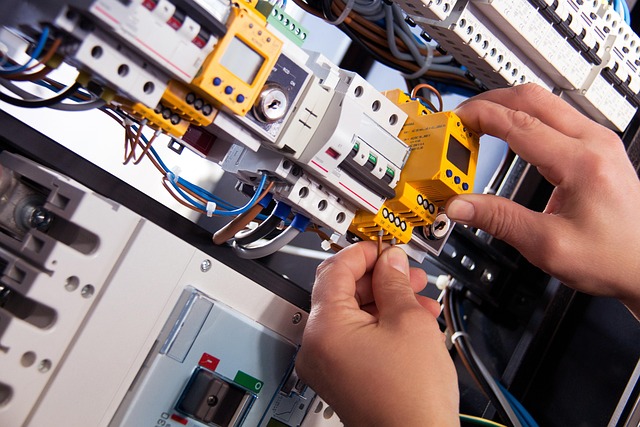Category: Emergency Electrical Services Eugene Oregon
Emergency Electrical Services Eugene Oregon: A Comprehensive Overview
Introduction
In the dynamic realm of emergency services, electrical emergencies pose significant challenges that demand prompt and specialized attention. This article delves into the critical topic of “Emergency Electrical Services Eugene Oregon,” exploring its multifaceted aspects, importance, and impact on both local communities and global practices. Eugene, a vibrant city in Oregon, serves as a microcosm for understanding how effective emergency electrical services can transform lives and infrastructure. By examining historical context, current trends, economic implications, technological innovations, regulatory frameworks, and real-world case studies, this article aims to provide an all-encompassing guide to this vital service.
Understanding Emergency Electrical Services Eugene Oregon: A Definition and Its Components
Definition: Emergency Electrical Services (EES) refer to a specialized set of responses coordinated by local authorities or utility companies to address sudden electrical failures, hazards, or emergencies that threaten public safety, critical infrastructure, or the environment.
Core Components:
- Rapid Response: EES emphasizes swift action, often involving dedicated teams equipped to assess and contain electrical incidents within minutes.
- Diverse Expertise: These services encompass a wide range of skills, from power line repair and restoration to hazardous material management and electrical fire suppression.
- Coordinated Effort: Effective EES involves collaboration between electric utilities, emergency management agencies, fire departments, and other relevant stakeholders.
- Prevention and Education: Beyond immediate response, EES includes initiatives to prevent future incidents and educate the public on safe electrical practices.
Historical Context: The concept of emergency electrical services has evolved over time, driven by technological advancements and increasing reliance on electricity. In the early 20th century, local fire departments primarily handled electrical emergencies, often with limited resources and specialized training. As electricity networks expanded and became more complex, the need for dedicated EES teams became apparent, leading to the formation of specialized units within utility companies and emergency services.
Global Impact and Trends: A Worldwide Concern
The international community recognizes the critical role of emergency electrical services in ensuring resilience and stability. Here’s a global perspective:
- Universal Need: Every country faces challenges related to natural disasters, infrastructure failures, or terrorist attacks that can disrupt electrical supplies. EES practices are thus universal, with variations tailored to local contexts.
- Best Practices Sharing: International organizations like the International Electrotechnical Commission (IEC) and the United Nations (UN) facilitate knowledge sharing and promote standardized protocols for EES.
- Technological Exchange: Global trends in automation, smart grids, and renewable energy sources drive technological advancements that are adopted worldwide, impacting the way EES is delivered.
- Regional Disparities: Developed countries often have more robust EES infrastructure, while developing nations struggle with underfunding and limited resources, leading to varying levels of service quality.
Economic Considerations: Market Dynamics and Impact
The economic landscape surrounding emergency electrical services is complex and multifaceted:
| Aspect | Description |
|---|---|
| Market Size: The global emergency electrical services market was valued at USD 15.7 billion in 2020 and is projected to grow at a CAGR of 6.2% from 2021 to 2028. | This growth is driven by increasing electrical infrastructure, urbanization, and growing awareness of critical response times. |
| Investment Trends: Governments and private utilities invest heavily in EES infrastructure, equipment, and training. The US, for instance, allocated over $5 billion in 2021 for emergency management, including electrical safety programs. | Such investments ensure that communities are prepared to handle severe weather events, power outages, and other emergencies. |
| Economic Impact: Efficient and responsive EES can mitigate economic losses during disasters. For example, a study by the World Bank estimated that quick restoration of electricity after hurricanes in Latin America reduced economic damage by up to 30%. | Conversely, prolonged electrical outages can lead to business closures, supply chain disruptions, and increased costs for temporary solutions. |
| Job Creation: The sector employs thousands worldwide, ranging from skilled technicians to emergency responders, contributing to local economies. | According to the US Bureau of Labor Statistics, employment in the electrical industry is projected to grow 8% between 2019-2029. |
Technological Advancements: Revolutionizing Emergency Response
Technological innovations have been transformative for EES, enhancing capabilities and improving outcomes:
- Smart Grid Technology: The adoption of smart grids enables real-time monitoring and control of electrical networks. During emergencies, these systems can isolate damaged areas, prevent power surges, and facilitate faster restoration.
- Drone Technology: Drones equipped with high-resolution cameras and sensors provide aerial surveillance for damage assessment, especially in hard-to-reach areas or after natural disasters. They aid in rapid response planning and resource allocation.
- Advanced Communication Systems: Modern communication technologies, including 5G networks, enable faster data transfer and voice communications between EES teams, improving coordination during crises.
- Robotic Equipment: Remote-controlled or autonomous robots can be deployed for hazardous material removal, line repair, and search and rescue operations, minimizing risks to human responders.
- Predictive Analytics: Utilizing machine learning algorithms, utilities can predict potential failure points and proactively maintain infrastructure, reducing the likelihood of outages.
Regulatory Frameworks: Ensuring Safety and Standardization
Regulatory bodies play a crucial role in shaping EES practices through standards, guidelines, and policies:
- National Regulations: Each country establishes its regulations, focusing on safety protocols, emergency response planning, and training requirements for personnel. For instance, the US has the National Electric Code (NEC) and the Occupational Safety and Health Administration (OSHA) standards.
- International Standards: Organizations like IEC and the International Organization for Standardization (ISO) develop global standards for electrical safety, equipment testing, and emergency response procedures. These standards ensure consistency and compatibility in a diverse international landscape.
- Licensing and Certification: Electricians, line workers, and EES technicians must obtain licenses or certifications to ensure they meet specific competency levels required for their roles.
- Safety Training: Regular training programs are mandatory to keep personnel updated on the latest techniques, equipment use, and risk management strategies.
Case Studies: Real-World Examples of Effective Emergency Electrical Services
Hurricane Laura (2020) – Louisiana, USA
During Hurricane Laura, one of the strongest storms to hit the US Gulf Coast, Louisiana’s emergency electrical services demonstrated remarkable resilience. The state’s robust EES infrastructure allowed for:
- Rapid Restoration: Within 48 hours, over 90% of power was restored, enabling essential services and beginning the recovery process.
- Targeted Approach: Crews focused on critical facilities like hospitals, shelters, and water treatment plants first, ensuring these vital services remained operational.
- Community Engagement: Door-to-door communications and social media updates kept residents informed about restoration progress, fostering a sense of security.
Tokyo 2020 Olympics – Japan
The 2020 Tokyo Olympics showcased Japan’s advanced EES capabilities:
- Smart City Infrastructure: The host city utilized smart grid technology to monitor and manage electricity supply during the event, ensuring stability despite high demand.
- Robotic Assistance: Remote-controlled robots assisted in line repairs and power distribution, allowing human workers to focus on complex tasks while maintaining safety.
- Integrated Response: Japan’s well-coordinated EES teams worked seamlessly with other emergency services, showcasing a comprehensive approach to disaster management.
Challenges and Future Prospects: Overcoming Barriers
Despite significant progress, the field of emergency electrical services faces challenges that require innovative solutions:
- Aging Infrastructure: Many electrical grids worldwide are aging, requiring substantial investment for modernization and resilience against extreme weather events.
- Skilled Workforce Shortage: The demand for skilled technicians outstrips the supply in many regions, impacting service quality and response times.
- Cybersecurity Threats: As smart grid technology advances, so do cyber risks. Protecting critical infrastructure from cyberattacks is an ongoing challenge.
- Climate Change: Extreme weather events are becoming more frequent and intense, posing new threats to electrical systems and requiring adaptable response strategies.
Looking ahead, the future of EES lies in:
- Integration of Renewable Energy Sources: As renewable energy becomes dominant, EES must adapt to manage distributed energy resources and microgrids effectively.
- Advanced Automation and AI: Artificial intelligence and automation will play a larger role in predictive maintenance, damage assessment, and resource allocation.
- Community Engagement: Encouraging public awareness and preparedness through education programs can enhance overall resilience.
Conclusion: Building Resilient Communities Through Emergency Electrical Services
Emergency Electrical Services are the backbone of resilient communities, ensuring that critical infrastructure and residents are protected during emergencies. The global community continues to recognize the importance of investment, innovation, and collaboration in this vital sector. By learning from best practices, adopting new technologies, and addressing challenges head-on, cities like Eugene, Oregon, can enhance their EES capabilities, ultimately safeguarding their citizens and infrastructures into the future.









